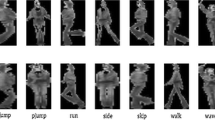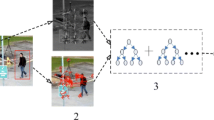Abstract
We propose a novel pedestrian detection approach in the extreme Low-Resolution (LR) images via sparse representation. Pedestrian detection in the extreme LR images is very important for some specific applications such as abnormal event detection and video forensics from surveillance videos. Although the pedestrian detection in High-Resolution (HR) images has achieved remarkable progress, it is still a challenging task in the LR images, because the discriminative information in the HR images usually disappear in the LR ones. It makes the precision of the detectors in the LR images decrease by a large margin. Most of the traditional methods enlarge the LR image by the linear interpolation methods. However, it can not preserve the high frequency information very well, which is very important for the detectors. For solving this problem, we reconstruct the LR image in the high resolution by sparse representation. In our model, the LR and HR dictionaries are established respectively in the training stage, and the representative coefficients mapping relations are determined. Moreover, for improving the speed of feature extraction, the feature reconstruction in the LR images is converted to the sparse linear combination between the coefficients and the response of the atoms in HR dictionary by the LR-HR mapping, no matter how complex the feature extraction is. Experiments on the four challenging datasets: Caltech, INRIA, ETH and TUD-Brussels, demonstrate that our proposed method outperforms the state-of-the-art approaches and is much efficient with more than 10 times speedup.
Access this chapter
Tax calculation will be finalised at checkout
Purchases are for personal use only
Similar content being viewed by others
References
Aytar, Y., Zisserman, A.: Tabula rasa: model transfer for object category detection. In: IEEE International Conference on Computer Vision, pp. 2252–2259 (2011)
Benenson, R., Mathias, M., Timofte, R., Gool, L.V.: Pedestrian detection at 100 frames per second. In: IEEE Conference on Computer Vision and Pattern Recognition, vol. 157, pp. 2903–2910 (2012)
Cevikalp, H., Triggs, B.: Efficient object detection using cascades of nearest convex model classifiers. In: IEEE Conference on Computer Vision and Pattern Recognition, pp. 3138–3145 (2012)
Dalal, N., Triggs, B.: Histograms of oriented gradients for human detection. In: IEEE Conference on Computer Vision and Pattern Recognition, pp. 886–893 (2005)
Dollar, P., Appel, R., Belongie, S., Perona, P.: Fast feature pyramids for object detection. IEEE Trans. Pattern Anal. Mach. Intell. 36(8), 1532–1545 (2014)
Dollar, P., Wojek, C., Schiele, B., Perona, P.: Pedestrian detection: an evaluation of the state of the art. IEEE Trans. Pattern Anal. Mach. Intell. 34(4), 743–761 (2012)
Dollar, P., Belongie, S., Perona, P.: The fastest pedestrian detector in the west. In: Proceedings of the British Machine Vision Conference, BMVC 2010, Aberystwyth, UK, 31 August - 3 September, pp. 1–11 (2010)
Ess, A., Leibe, B., Gool, L.V.: Depth and appearance for mobile scene analysis. In: IEEE International Conference on Computer Vision, pp. 1–8 (2007)
Felzenszwalb, P.F., Girshick, R.B., Mcallester, D.: Cascade object detection with deformable part models. In: IEEE Conference on Computer Vision and Pattern Recognition, pp. 2241–2248 (2010)
Felzenszwalb, P.F., Girshick, R.B., Mcallester, D., Ramanan, D.: Object detection with discriminatively trained part-based models. IEEE Trans. Pattern Anal. Mach. Intell. 32(9), 1627–1645 (2014)
Jiang, J., Hu, R., Han, Z., Huang, K.: Efficient single image super-resolution via graph embedding. In: IEEE International Conference on Multimedia and Expo, pp. 610–615 (2012)
Jiang, J., Hu, R., Wang, Z., Han, Z.: Manifold regularized sparse support regression for single image super-resolution. In: IEEE International Conference on Acoustics, Speech and Signal Processing, vol. 32, pp. 1429–1433 (2013)
Lee, H., Battle, A., Raina, R., Ng, A.Y.: Efficient sparse coding algorithms. In: Advances in Neural Information Processing Systems, pp. 801–809 (2007)
Rahtu, E., Kannala, J., Blaschko, M.: Learning a category independent object detection cascade. In: IEEE International Conference on Computer Vision, vol. 23, pp. 1052–1059 (2011)
Ren, X., Ramanan, D.: Histograms of sparse codes for object detection. In: IEEE Conference on Computer Vision and Pattern Recognition, vol. 9, pp. 3246–3253 (2013)
Shen, B., Si, L.: Non-negative matrix factorization clustering on multiple manifolds (2010)
Sun, M., Savarese, S.: Articulated part-based model for joint object detection and pose estimation. In: IEEE Conference on Computer Vision and Pattern Recognition, vol. 23, pp. 723–730 (2011)
Tu, Z., Perona, P., Belongie, S.: Pasadena: integral channel features. 2(3), 5–11 (2009)
Vijayanarasimhan, S., Grauman, K.: Efficient region search for object detection. 42(7), 1401–1408 (2011)
Wang, X., Han, T.X., Yan, S.: An HOG-LBP human detector with partial occlusion handling. In: IEEE International Conference on Computer Vision, pp. 32–39 (2009)
Wojek, C., Walk, S., Schiele, B.: Multi-cue onboard pedestrian detection. In: IEEE Conference on Computer Vision and Pattern Recognition, pp. 794–801 (2009)
Acknowledgement
The research was supported by National High Technology Research and Development Program of China (2015AA016306), National Nature Science Foundation of China (61231015, 61671336, 61671332, 61562048), Natural Science Fundation of JiangSu Province (BK20160386), the EU FP7 QUICK project under Grant Agreement (PIRSES-GA-2013-612652), the Technology Research Program of Ministry of Public Security (2016JSYJA12), the Fundamental Research Funds for the Central Universities (2042014kf0250, 2014211020203).
Author information
Authors and Affiliations
Corresponding author
Editor information
Editors and Affiliations
Rights and permissions
Copyright information
© 2017 Springer International Publishing AG
About this paper
Cite this paper
Fang, W., Chen, J., Hu, R. (2017). Efficient Pedestrian Detection in the Low Resolution via Sparse Representation with Sparse Support Regression. In: Kim, J., Shim, K., Cao, L., Lee, JG., Lin, X., Moon, YS. (eds) Advances in Knowledge Discovery and Data Mining. PAKDD 2017. Lecture Notes in Computer Science(), vol 10235. Springer, Cham. https://doi.org/10.1007/978-3-319-57529-2_25
Download citation
DOI: https://doi.org/10.1007/978-3-319-57529-2_25
Published:
Publisher Name: Springer, Cham
Print ISBN: 978-3-319-57528-5
Online ISBN: 978-3-319-57529-2
eBook Packages: Computer ScienceComputer Science (R0)




